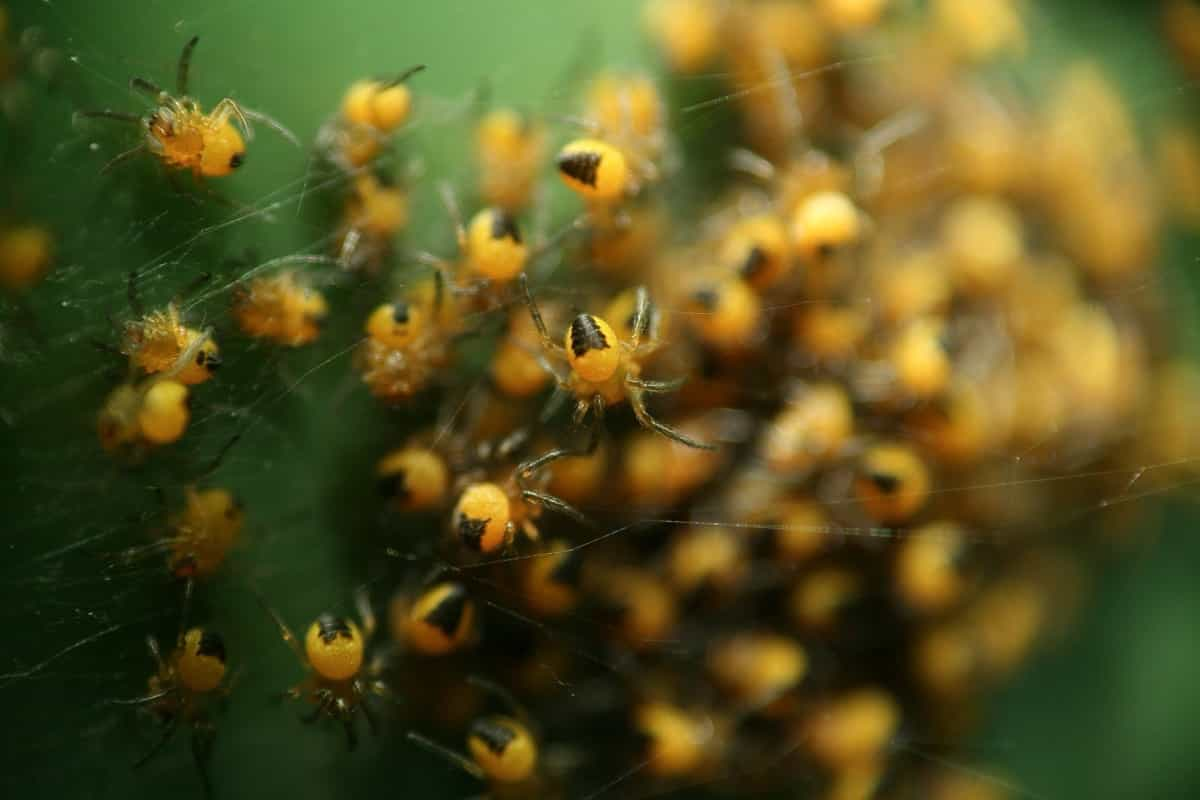Extracted from the neem tree’s seeds (Azadirachta indica), neem oil stands as a powerful natural remedy for controlling spider mites on plants. With a rich history in traditional medicine and agriculture, neem oil is renowned for its pesticidal and medicinal properties. It serves as a sustainable and eco-friendly alternative to synthetic pesticides, ensuring the health and vitality of plants while combating the menace of spider mites.

Neem Oil Application for Spider Mites Control
Neem Oil and its Benefits for Spider Mites
Neem oil is a multifaceted solution in the battle against spider mites. Its active compounds, like azadirachtin, disrupt the life cycle of these pests, inhibiting their feeding and reproductive capabilities. Furthermore, neem oil acts as a repellent, deterring spider mites from infesting plants.
Unlike chemical pesticides, neem oil is non-toxic to humans, animals, and beneficial insects, preserving the overall ecological balance in the garden. Regular use of neem oil not only eliminates existing spider mite infestations but also prevents future outbreaks, promoting sustainable and long-term plant health.
How to Prepare Neem Oil to Use on Spider Mites
To prepare neem oil for effective use against spider mites, start with high-quality, cold-pressed neem oil, which retains its beneficial compounds. Begin by choosing a neem oil product without additional additives for optimal purity. Mixing the neem oil with a mild liquid soap or organic insecticidal soap enhances its effectiveness. The soap will act as an emulsifier, helping the oil disperse in water and adhere to the plant surfaces.
Dilute two teaspoons of neem oil to one liter of warm water, and include a teaspoon of soap. Stir the solution thoroughly to ensure a well-blended mixture. For increased efficacy, use a container with a lid and shake the solution vigorously until it becomes milky in appearance. This neem oil spray is now ready for application on plants affected by spider mites.
How to Apply Neem Oil on Spider Mites
Apply the neem oil spray early in the morning or late in the afternoon when the sun is not intense. Ensure the plant is well-hydrated before application, as this helps the neem oil adhere to the leaves. Using a spray bottle, cover both the upper and lower surfaces of the leaves with the neem oil solution, paying extra attention to areas with visible spider mite damage. Reapply the neem oil spray every 7-14 days until the infestation is under control.
In case you missed it: How to Get Rid of Spider Mites on Indoor Plants: Natural and Organic Remedies

Be consistent with applications, especially during peak spider mite seasons. As neem oil breaks down rapidly in sunlight, it is advisable to treat plants in the evening for prolonged efficacy. Regular use of neem oil not only eradicates existing spider mite colonies but also reinforces the plant’s natural defenses, fostering a pest-resistant environment.
Mixing and Dilution for the Right Concentration of Neem Oil for Spider Mites
To mix and dilute neem oil for the right concentration, start by adding one to two teaspoons of neem oil to one liter of warm water. The exact concentration may vary based on the severity of the infestation and the specific neem oil product used, so it’s essential to follow the manufacturer’s guidelines. To enhance the neem oil’s adherence and effectiveness, include a teaspoon of mild liquid soap or organic insecticidal soap.
The soap serves as an emulsifier, helping the neem oil disperse evenly in the water. Stir the solution thoroughly to ensure proper blending. For a more accurate concentration, consider using a container with measurement markings or a graduated cylinder. After mixing, shake the solution vigorously until it turns milky in appearance. This neem oil solution is now ready for application on plants affected by spider mites.
How Long Does Neem Oil Stay Effective on Spider Mites?
The effectiveness of neem oil on spider mites will vary based on factors like weather conditions, plant growth, and the severity of the infestation. In general, neem oil has a residual effect that lasts for about 7 to 14 days after application. It is advisable to reapply the neem oil spray regularly to maintain its efficacy. Frequent applications every 7-14 days help disrupt the life cycle of spider mites and prevent the resurgence of their populations.
Using Neem Oil Along with Other Pest Control Methods
Neem oil can be part of an integrated pest management strategy when combined with natural enemies and cultural practices. Beneficial insects like small lady beetles, predatory mites, minute pirate bugs, big-eyed bugs, and predatory thrips are natural predators of spider mites. By fostering a habitat that supports these beneficial insects, you create a balanced ecosystem that helps control spider mite populations.
Cultural practices, such as regular pruning, maintaining proper plant spacing, and ensuring adequate watering, contribute to overall plant health and resilience. These practices reduce stress on plants, making them less susceptible to spider mite infestations.
Some Common Pests and Diseases That Neem Oil Can Control on Spider Mites
Neem oil, known for its broad-spectrum activity, is effective against various pests and diseases, providing comprehensive plant protection. Besides controlling spider mites, neem oil can combat aphids, whiteflies, thrips, mealybugs, and scales. It also exhibits antifungal properties, making it useful against rust, powdery mildew, downy mildew, and other fungal diseases.
In case you missed it: How to Protect Cucumbers from Aphids, Mites, and Beetles: Naturally and Organically

By combining neem oil with these integrated pest management practices, you create a holistic approach to pest control that is environmentally friendly and sustainable and helps maintain a healthy and thriving garden.
How to Monitor the Effectiveness of Neem Oil on Spider Mites
Observe the undersides of leaves for webbing, stippling, or tiny moving specks—indicators of live spider mites. Check for any new damage or the persistence of existing symptoms. If the population is decreasing, and new growth appears healthier, it suggests positive results. Consider using a hand lens for a closer examination. Additionally, monitor the overall health and vigor of the plants.
Healthy plants are more resistant to pests. If spider mite activity persists, increase the frequency of neem oil applications. Document observations over time to track changes in the infestation. A decline in spider mite numbers and visible improvement in plant health indicate the continued effectiveness of neem oil in managing the pest problem.
Safety Precautions to Take When Using Neem Oil on Spider Mites
- Use protective gear, like safety glasses or goggles, to shield eyes from accidental splashes or spray drift during the application.
- Apply neem oil in a well-ventilated area to avoid inhaling fumes. If working in an enclosed space, use a mask to reduce inhalation risks.
- Follow the label instructions on the neem oil product. Adhere to recommended dilution ratios, application frequencies, and safety guidelines provided on the label.
- Prevent contamination of neem oil by using dedicated equipment for mixing and applying.
- Apply neem oil early in the morning or late in the afternoon when temperatures are low and beneficial insects are less active.
- Before widespread application, conduct a patch test on a small portion of the plant to ensure it does not negatively react to the neem oil.
In case you missed it: How to Control Chicken Mites Naturally and Prevent Their Recurrence

Conclusion
In conclusion, neem oil stands as a natural and effective solution for controlling spider mites on plants. Its multifaceted approach disrupts the pests’ life cycle, acts as a repellent, and promotes plant health. By incorporating neem oil into a holistic pest management strategy, gardeners can foster a balanced ecosystem, ensuring long-term protection against spider mites while preserving the vitality of their plants in an environmentally friendly manner.
- Feed Your Flock for Less: Top 10 Tips to Save on Chicken Feed
- Ultimate Guide to Ossabaw Island Hog: Breeding, Raising, Diet, and Care
- Hatching Answers: The Top 10 Reasons Your Chickens Aren’t Laying Eggs
- Eggs and Economics: Breaking Down the Cost of Raising Backyard Chickens
- Defend Your Greens: Proven Methods to Keep Iguanas Out of Your Garden
- Ultimate Guide to Cinnamon Queen Chicken: A Comprehensive Guide for Beginners
- Ultimate Guide to California Tan Chicken: Breeding, Raising, Diet, Egg-Production and Care
- Ultimate Guide to Marsh Daisy Chicken: Breeding, Raising, Diet, and Care
- 10 Types of Chicken Farming Businesses You Can Start for Profits